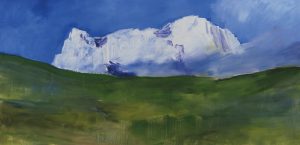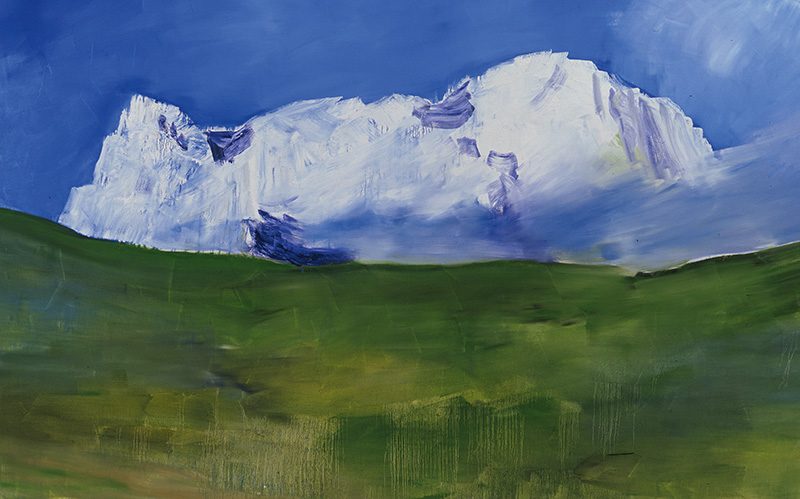
Markus Pernhart, Alfons Walde, Maria Lassnig, Herbert Brandl … Austrian artists explore the mountain landscape in different ways, their work commanding prices as high as those lofty peaks. An excursion through Austrian mountain painting.
Land of mountain peaks … Austria and mountains go together like Sacher Torte and Viennese Melange coffee. The snow-capped peaks have always been both a place of spiritual yearning and of formidable adventure, as awe-inspiring as they are seductive, at once a symbol of the Divine and the subject of scientific enquiry. Nature sets mankind a limit in the colossal rock formations of the Alps. Overcoming the challenge of this natural boundary is inherent to the Alpine theme, both figuratively in artistic depictions of great endeavour as well as in practice, as we see, for instance in Hannibal’s crossing of the Alps, ever a popular subject even for artists as far removed as J. M. W. Turner. After all, what better motif to depict the transcendent than the mountain, that great connector of heaven and earth?
The following is an overview of various artistic approaches Austrian artists have taken since the 19th century: how did they confront “their” Alps?
Markus Pernhart – The Artist-Mountainer
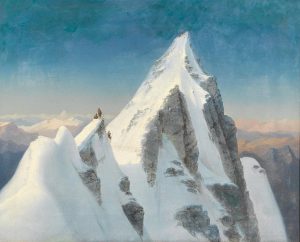
Mountains and landscapes emerged from the background of paintings to the foreground of art history after the 15th century. In the 1700s they became the very canvas for developing concepts of philosophy as we see, for example, in Kant and Schiller’s notion of sublime nature. By the 19th century, landscape and, in the Austrian context particularly mountains, had become symbolic apotheosis of national identity.
Markus Pernhart’s impressive depiction of the Grossglockner – Austria’s highest mountain at 3,798 metres – can be viewed in this light. Pernhart, a notable landscape painter, gained renown for his numerous depictions of his native province of Carinthia. Even the Empress Elisabeth, or Kaiserin Sissi as she was known, included 31 of his drawings of Carinthian landmarks, and one of his paintings of the Grossglockner, in her collection. Pernhart famously spent days on end in inhospitable terrain producing topographically accurate images, even taking a small stove with him onto the mountain with which to thaw the ice-cold paints so that he could mix them at high altitudes. Depictions of the Grossglockner, which Pernhart is said to have climbed ten times, are amongst the most impressive of the artist’s work. The central theme of the paintings is clearly the boundlessness of unspoilt nature. Tiny mountaineers, shown en route to the summit, convey the vastness of the breath-taking mountain scenery and provide the viewer with a sense of the camaraderie and the exhilaration of man’s experience in the mountains.
Alfons Walde – Chronicler of the Modern Age
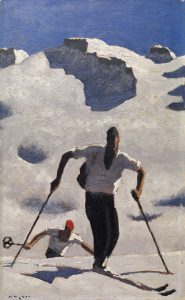
The turn of the century saw a new development as lone climbers and organised teams began to ascend the highest peaks of the Alps. The early 20th century saw the emergence of the Alps as a destination for winter sports for the increasing numbers of people seeking escape from the cities. Alfons Walde’s compositionally sophisticated depictions of mountain and winter landscapes bear witness to this epoch of alpine life. One of the cradles of Austrian skiing is Kitzbühel, as Gert Amman writes in “Wintersport” (Leopold Museum catalogue). The town grew into a first-class winter sports location from 1897 onwards, a development that the youthful Alfons Walde experienced first-hand while growing up there. He began painting pictures of winter sports in the 1910s. At the heart of these pictures is the sheer vitality that accompanies this activity, as well as the harmony of man and nature that it entails. It is no wonder that Walde’s depictions have had a lasting impact on the overall image of Tyrol. A number of his motifs, such as “The Ascent” from 1927, were featured in contemporary Tyrolean tourist posters.
His depictions of snow-covered winter landscapes reached perfection in the 1930s. Typical of Walde are the compositional balance of natural space and architectural elements of man and nature, the impasto application of paint, and his masterly modelling of light and shadow on snowy surfaces.
Maria Lassnig – Anthropomorphic Landscape
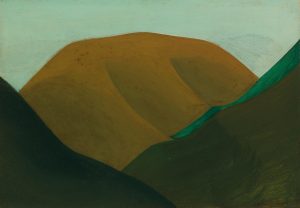
Maria Lassnig also hailed from the Austria’s alpine region and remained loyal to her subject into her old age. She spent the summer months and the Christmas season near Feistritz in Carinthia. Lassnig was not a landscape painter in the true sense of the word, as the starting point for her painting was always her own body. But that is not all it was. “I always start with the experience of the body, but then world problems that preoccupy me come into play, the way in which humans mistreat and decimate nature, for instance. … It is the same with flowers; the landscape looks like it’s been hoovered. Paths through the woods are like wounds in the forest.” (Maria Lassnig in a “Der Standard” newspaper interview with Andrea Schurian, 1 June 2013)
Lassnig’s relationship with the mountains was manifold: they were her place of origin and retreat, but above all the place where she made contact with nature. Protecting and preserving them was a concern of hers, as evidenced by her 1986 work “Das Rehlein” (The Fawn), which she painted in the year of the Chernobyl disaster. Existential and mythological themes manifested in nature are her central subject matter, as we see in her self-portrait as a Grim Reaper in front of a mountain backdrop (“Senner auf der Alm / Sensenmann”, 1985), in the “Atlas” paintings from 1985, or in the watercolour “Alpenkaryatide” from 1982, in which the artist is seen shouldering the mountains like the eponymous mythological figure. Though the majority of Lassnig’s paintings are self-portraits, they never exhaust themselves in the depiction of her person and are often described as body landscapes. “Anthropomorphic Landscape”, the previous title of an early painting from 1955, suggests that even her landscapes are not content with being merely landscapes.
Herbert Brandl – The Mountain Seer
Herbert Brandl, probably the most prominent contemporary mountain painter, breaks new ground in Alpine painting. He turns his back on the kitsch and the romanticism of the 19th century, and on the occupation of mountains by civilisation, the image of the “mountain as mountain” and turns towards the image of the mountain as picture. As he puts it, “I wipe tourism from the mountains. I have returned the mountains to art.” (Herbert Brandl in a “Der Standard” newspaper interview with Andrea Schurian, 20 October 2010).
Since the turn of the Millennium, the painter has shifted his focus to depicting mountains and landscapes or, as he explains, he has “entered the mountainous phase” of his work. He paints from images published in magazines and catalogues or allows the sight of rock formations experienced while hiking to sink in, until they reappear on canvas, sometimes years after he first took them in. He considers himself a “mountain seer” rather than a mountain climber, and as a painter. The mountains only provide him with the scaffolding he needs to put paint to canvas. The result are paintings that oscillate between the figurative and the abstract. They address both representation and the represented, using layers of paint applied and removed, and the use of brush strokes and other material properties. They are paintings with both a strong emotional effect and a distinctly
analytical dimension.
